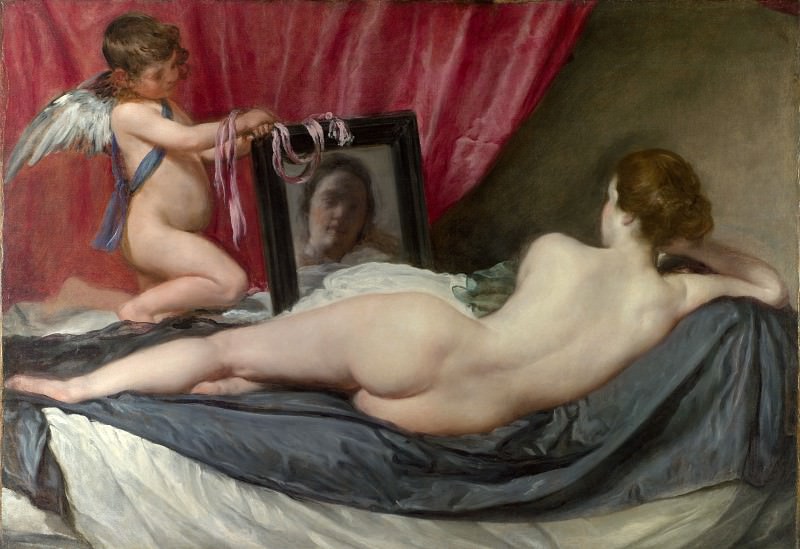The Toilet of Venus (The Rokeby Venus) Diego Rodriguez De Silva y Velazquez (1599-1660)
Diego Rodriguez De Silva y Velazquez – The Toilet of Venus (The Rokeby Venus)
Edit attribution
Image taken from other album: gallerix.org/s/623387687/N/2034414100/
Download full size: 6162×4226 px (9,5 Mb)
Painter: Diego Rodriguez De Silva y Velazquez
Location: National Gallery, London.
During the life of the artist Diego Velázquez, the Spanish Inquisition had a great influence not only on people’s lives and mores, but also on their art. In those days, depictions of nude bodies were under strict prohibition. An artist who painted a portrait of a nude could be sent into exile, deprived of church patronage, and his picture could be burned or repainted. Like many other creative people, Velázquez did not adhere to the strict framework set by the authorities and created his one-of-a-kind work, Venus Before the Mirror. In ancient mythology, the goddess Venus embodied the symbol of love as well as the sublime and beautiful beauty of women.
Description of the painting "Venus with Mirror" by Diego Velazquez
During the life of the artist Diego Velázquez, the Spanish Inquisition had a great influence not only on people’s lives and mores, but also on their art. In those days, depictions of nude bodies were under strict prohibition.
An artist who painted a portrait of a nude could be sent into exile, deprived of church patronage, and his picture could be burned or repainted. Like many other creative people, Velázquez did not adhere to the strict framework set by the authorities and created his one-of-a-kind work, Venus Before the Mirror.
In ancient mythology, the goddess Venus embodied the symbol of love as well as the sublime and beautiful beauty of women. In this painting, she is depicted reclining on a thin, flowing bedspread. Her back is turned to the spectator with her knees half bent. In ancient times, Venus was often depicted in such a perspective. The artist concentrated viewers’ attention on the beauty of the female body, deliberately avoiding luxury drapery and excluding jewelry such as flowers and jewels.
The second character in the painting is Cupid, son of the goddess. Instead of the bow and arrow with which he is habitually portrayed, the child supports a mirror turned toward his mother. In the reflection you can see the fuzzy features of Vinera’s face, meet her eyes with her gaze. Velázquez deliberately depicts her reflection as irregular, larger than it should be.
The folds of the sheets repeat the contours of the figure of the Roman goddess. Thus the artist emphasizes her softness and lushness of form. The main colors of the background composition are quite simple - white, red and gray, but critics liked this range.
Constrained by church dogmas, Velázquez could not put his painting on public view. So for a long time it was seen only in narrow circles. Only in the 19th century was it transported to England, and to this day it is kept in the National Gallery in London.
Кому понравилось
Пожалуйста, подождите
На эту операцию может потребоваться несколько секунд.
Информация появится в новом окне,
если открытие новых окон не запрещено в настройках вашего браузера.
You need to login
Для работы с коллекциями – пожалуйста, войдите в аккаунт (open in new window).

















COMMENTS: 1 Ответы
В романе Фейхтвангера "Гойя, или Тяжкий путь познания" фигура Венеры описывается как "типично испанская".
You cannot comment Why?
This painting depicts Venus, the Roman goddess of love and beauty, reclining on a bed. She is shown from behind, gazing into a hand mirror held by Cupid, her son. Her body is softly lit, highlighting her curves and pale skin. Dark drapery and rich red fabric frame the scene, adding to the opulent atmosphere.
The subtexts of the painting are rich and multifaceted:
The Toilet of Venus is a powerful exploration of beauty, desire, and the act of looking, inviting viewers to contemplate these themes through its masterful execution and symbolic richness.